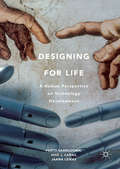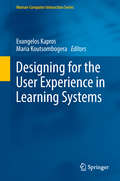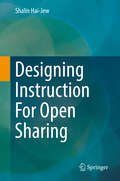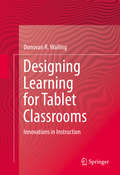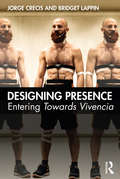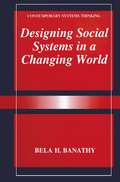- Table View
- List View
Designing for Life: A Human Perspective on Technology Development
by Pertti Saariluoma Jaana Leikas José J. CañasThroughout the chapters, the authors take readers through the various uses of technology. They discuss archifact analysis, usability and cognitive engineering, as well as motivation and emotion in user interface design. The book also crucially introduces a new, holistic approach to designing human-technology interaction. The book is suitable for researchers, postgraduate and undergraduate students of cognitive and social psychology as well as all those who are interested in technological design and its societal impact.
Designing for Science: Implications From Everyday, Classroom, and Professional Settings
by Kevin Crowley Christian D. Schunn Takeshi OkadaThis volume explores the integration of recent research on everyday, classroom, and professional scientific thinking. It brings together an international group of researchers to present core findings from each context; discuss connections between contexts, and explore structures; technologies, and environments to facilitate the development and practice of scientific thinking. The chapters focus on: * situations from young children visiting museums, * middle-school students collaborating in classrooms, * undergraduates learning about research methods, and * professional scientists engaged in cutting-edge research. A diverse set of approaches are represented, including sociocultural description of situated cognition, cognitive enthnography, educational design experiments, laboratory studies, and artificial intelligence. This unique mix of work from the three contexts deepens our understanding of each subfield while at the same time broadening our understanding of how each subfield articulates with broader issues of scientific thinking. To provide a common focus for exploring connections between everyday, instructional, and professional scientific thinking, the book uses a "practical implications" subtheme. In particular, each chapter has direct implications for the design of learning environments to facilitate scientific thinking.
Designing for Science: Implications From Everyday, Classroom, and Professional Settings
by Kevin Crowley Christian D. Schunn Takeshi OkadaThis volume explores the integration of recent research on everyday, classroom, and professional scientific thinking. It brings together an international group of researchers to present core findings from each context; discuss connections between contexts, and explore structures; technologies, and environments to facilitate the development and practice of scientific thinking. The chapters focus on: * situations from young children visiting museums, * middle-school students collaborating in classrooms, * undergraduates learning about research methods, and * professional scientists engaged in cutting-edge research. A diverse set of approaches are represented, including sociocultural description of situated cognition, cognitive enthnography, educational design experiments, laboratory studies, and artificial intelligence. This unique mix of work from the three contexts deepens our understanding of each subfield while at the same time broadening our understanding of how each subfield articulates with broader issues of scientific thinking. To provide a common focus for exploring connections between everyday, instructional, and professional scientific thinking, the book uses a "practical implications" subtheme. In particular, each chapter has direct implications for the design of learning environments to facilitate scientific thinking.
Designing for the User Experience in Learning Systems (Human–Computer Interaction Series)
by Evangelos Kapros Maria KoutsombogeraWhile the focus of the UX research and design discipline and the Learning Sciences and instructional design disciplines is often similar and almost always tangential, there seems to exist a gap, i.e. a lack of communication between the two fields. Not much has been said about how UX Design can work hand-in-hand with instructional design to advance learning. The goal of this book is to bridge this gap by presenting work that cuts through both fields. To illustrate this gap in more detail, we provide a combined view of UX Research and Design & Educational Technology. While the traditional view has perceived the Learning Experience Design as a field of Instructional Design, we will highlight its connection with UX, an aspect that has become increasingly relevant. Our focus on user experience research and design has a unique emphasis on the human learning experience: we strongly believe that in learning technology the technological part is only mediating the learning experience, and we do not focus on technological advancements per se, as we believe they are not the solution, in themselves, to the problems that education is facing. This book aims to lay out the challenges and opportunities in this field and highlight them through research presented in the various chapters. Thus, it presents a unique opportunity to represent areas of learning technology that go very far beyond the MOOC and the classroom technology. The book provides an outstanding overview and insights in the area and it aims to serve as a significant and valuable source for learning researchers and practitioners. The chapter "User requirements when designing learning e-content: interaction for all" is available open access under a CC BY 4.0 license at link.springer.com
Designing, Implementing, and Managing Treatment Services for Individuals with Co-Occurring Mental Health and Substance Use Disorders: Blueprints for Action
by Edward L. HendricksonYour blueprint to develop and manage effective co-occurring treatment programs!Sequential or parallel treatments for co-occurring disorders are much less effective than a quality co-occurring treatment program. Most mental health and substance abuse professionals know how to provide an effective program for individuals with a substance use or mental health disorder, but few are aware of the issues involved in providing services for those with dual diagnosis. Designing, Implementing, and Managing Treatment Services for Individuals with Co-Occurring Mental Health and Substance Use Disorders: Blueprints for Action gives you with the tools you need to develop an effective program specific to co-occurring treatment as well as to implement and manage the program's services. Author Edward Hendrickson shares his knowledge from over two decades of developing and implementing co-occurring treatment services. Designing, Implementing, and Managing Treatment Services for Individuals with Co-Occurring Mental Health and Substance Use Disorders: Blueprints for Action is thorough, insightful, and informative, covering all facets of plan and execution, helping you form strategies to address a co-occurring treatment program&’s unique issues. The book examines the historical basis of the current dual treatment system to provide the philosophical tenets the program must follow and the essential qualities for an effective treatment program. It explores the issues in creating a new program or expanding an existing one, as well as the mechanics of day-to-day management. Helpful appendices, tables, and case examples illustrate the discussion.Designing, Implementing, and Managing Treatment Services for Individuals with Co-Occurring Mental Health and Substance Use Disorders: Blueprints for Action discusses: developing the necessary infrastructure for integrated treatment programs the eight essential qualities for an effective treatment program choosing a target population identifying specific services to implement implementation of services in an existing treatment setting implementation of services in a non-mental health or substance abuse setting hiring and training staff clinical supervision and human resource development program management issues multilevel and multi-organization systems steps to ensure program survivalDesigning, Implementing, and Managing Treatment Services for Individuals with Co-Occurring Mental Health and Substance Use Disorders: Blueprints for Action is more than an instructional text for students; it is an essential resource for any substance abuse and mental health professional considering implementing a co-occurring treatment program.
Designing, Implementing, and Managing Treatment Services for Individuals with Co-Occurring Mental Health and Substance Use Disorders: Blueprints for Action
by Edward L. HendricksonYour blueprint to develop and manage effective co-occurring treatment programs!Sequential or parallel treatments for co-occurring disorders are much less effective than a quality co-occurring treatment program. Most mental health and substance abuse professionals know how to provide an effective program for individuals with a substance use or mental health disorder, but few are aware of the issues involved in providing services for those with dual diagnosis. Designing, Implementing, and Managing Treatment Services for Individuals with Co-Occurring Mental Health and Substance Use Disorders: Blueprints for Action gives you with the tools you need to develop an effective program specific to co-occurring treatment as well as to implement and manage the program's services. Author Edward Hendrickson shares his knowledge from over two decades of developing and implementing co-occurring treatment services. Designing, Implementing, and Managing Treatment Services for Individuals with Co-Occurring Mental Health and Substance Use Disorders: Blueprints for Action is thorough, insightful, and informative, covering all facets of plan and execution, helping you form strategies to address a co-occurring treatment program&’s unique issues. The book examines the historical basis of the current dual treatment system to provide the philosophical tenets the program must follow and the essential qualities for an effective treatment program. It explores the issues in creating a new program or expanding an existing one, as well as the mechanics of day-to-day management. Helpful appendices, tables, and case examples illustrate the discussion.Designing, Implementing, and Managing Treatment Services for Individuals with Co-Occurring Mental Health and Substance Use Disorders: Blueprints for Action discusses: developing the necessary infrastructure for integrated treatment programs the eight essential qualities for an effective treatment program choosing a target population identifying specific services to implement implementation of services in an existing treatment setting implementation of services in a non-mental health or substance abuse setting hiring and training staff clinical supervision and human resource development program management issues multilevel and multi-organization systems steps to ensure program survivalDesigning, Implementing, and Managing Treatment Services for Individuals with Co-Occurring Mental Health and Substance Use Disorders: Blueprints for Action is more than an instructional text for students; it is an essential resource for any substance abuse and mental health professional considering implementing a co-occurring treatment program.
Designing Information Spaces: The Social Navigation Approach (Computer Supported Cooperative Work)
by Kristina Höök David Benyon Alan J. MunroSocial navigation is an emerging field which examines how we navigate information or locate services in both real and virtual environments and how we interact with and use others to find our way in information spaces. It has led to new ways of thinking about how we design information spaces and how we address usability issues, particularly in collaborative, web-based systems. This book follows on from Munro et al, Social Navigation of Information Space, which was the first major work in this field. It provides a similar broad overview of the field, but is much more practical in focus.
Designing Instruction For Open Sharing
by Shalin Hai-JewThis textbook considers and addresses the design of online learning objects, electronic textbooks, short courses, long courses, MOOC courses, and other types of contents for open sharing. It also considers the design of online mediated communities to enhance such learning. The “openness” may be open-access, and/or it may even be open-source. The learning may range from self-directed and automated to AI robot-led to instructor-led. The main concept of this work is that design learning for open sharing, requires different considerations than when designing for closed and proprietary contexts. Open sharing of learning contents requires a different sense of laws (intellectual property, learner privacy, pedagogical strategies, technologies, media, and others). It requires different considerations of learner diversity and inclusion. It requires geographical, cultural, and linguistic considerations that are not as present in more localized designs. The open sharing aspect also has effects on learner performance tracking (assessments) and learner feedback. This textbook targets students, both undergraduate and graduate in computer science, education and other related fields. Also, professionals in this field managing online systems would find this book helpful.
Designing Integrated Care Ecosystems: A Socio-Technical Perspective
by Bernard J. Mohr Ezra DessersThis book brings together research and theory about integrated care ecosystems with modern Socio-Technical Systems Design. It provides a practical framework for collaborative action and the potential for better care in every sense. By combining the aspirations, information, resources, activities, and the skills of public and private organizations, independent care providers, informal care givers, patients and other ecosystem actors, this framework makes possible results that none of the parties concerned can achieve independently It is both a design challenge and a call for innovation in how we think about health care co-creation. Illustrative stories from many countries highlight different aspects of integrated care ecosystems, their design and their functioning in ways that allow us to push the operating frontiers of what we today call our health care system. It explains what it means to design higher levels of coordination and collaboration into fragmented care ecosystems and explores who the participants should and can be in that process. Written for a broad audience including researchers, professionals, and policy makers, this book offers readers new thinking about what outcomes are possible and ways to achieve them.
Designing Learning for Tablet Classrooms: Innovations in Instruction
by Donovan R. WallingThe versatile, cost-effective technology of the tablet computer has proved to be a good fit with the learning capabilities of today's students. Not surprisingly, in more and more classrooms, the tablet has replaced not only traditional print materials but the desktop computer and the laptop as well.Designing Instruction for Tablet Classrooms makes sense of this transition, clearly showing not just how and why tablet-based learning works, but how it is likely to evolve.Written for the non-technical reader, it balances elegant theoretical background with practical applications suitable to learning environments from kindergarten through college. A wealth of specialized topics ranges from course management and troubleshooting to creating and customizing etextbooks, from tablet use in early and remedial reading to the pros and cons of virtual field trips. And for maximum usefulness, early chapters are organized to spotlight core skills needed to negotiate the new design frontier, including: Framing the learning design approach.Analyzing the learning environment.Designing learning that capitalizes on tablet technology.Developing activities that match learning needs.Implementing the learning design.Conducting evaluations before, during, and after.This is proactive reading befitting a future of exciting developments in educational technology. For researchers and practitioners in this and allied fields, Designing Instruction for Tablet Classrooms offers limitless opportunities to think outside the box.
Designing Luxury Brands: The Art and Science of Creating Game-Changers (Management for Professionals)
by Diana DervalThis book, a second offering after the successful first edition, shows how to build successful luxury brands using the power of sensory science and neuropsychology. The author presents inspiring business cases like Tesla Cybertruck, Chanel, KaDeWe, Baccarat, JACQUEMUS, NASA, MUD Jeans, Lilium, Rémy Cointreau, FENG J, Moncler, Louboutin, or Raffles Dubai in industries such as Fashion, Automotive or Leisure. The book highlights groundbreaking scientific methods - like the Derval Color Test® taken by over 30 million people - to help predict luxury shoppers’ preferences and purchasing patterns. Game-changing and unique features of successful luxury brands are decoded. Through various practical examples and experiments, readers will be able to build, revamp, or expand luxury brands and look at luxury from a new angle.
Designing Mind-Friendly Environments: Architecture and Design for Everyone
by Steve MaslinExploring the impact of the built environment and design on people with a range of neurological experiences, including autism, dementia, dyslexia and dyspraxia, this comprehensive guide shows how modifications to architecture and interior spaces can positively benefit the lives of everyone and advises on how to create and design 'mind friendly' environments.
Designing Positive Psychology: Taking Stock and Moving Forward (Series in Positive Psychology)
by Kennon M. Sheldon Todd B. Kashdan Michael F. StegerPositive psychology exploded into public consciousness 10 years ago and has continued to capture attention around the world ever since. The movement promised to study positive human nature, using only the most rigorous scientific tools and theories. How well has this promise been fulfilled? This book evaluates the first decade of this fledgling field of study from the perspective of nearly every leading researcher in the field. Scholars in the areas of social, personality, clinical, biological, emotional, and applied psychology take stock of their fields, while bearing in mind the original manifesto and goals of the postive psychology movement. They provide honest, critical evaluations of the flaws and untapped potential of their fields of study. The contributors design the optimal future of positive psychology by addressing gaps, biases, and methodological limitations, and exploring exciting new questions.
Designing Presence: Entering Towards Vivencia
by Jorge Crecis Bridget LappinDesigning Presence offers a unique insight into the training that has helped people around the world to cultivate more presence in both professional and personal settings. It explains the research behind the method of Towards Vivencia, shares stories of how it has been implemented and offers practical exercises to apply it in any context. Presence is something that is often talked about but is difficult to pin down. We have all experienced moments when we felt one with what we are doing and with our environment. However, this feeling is usually fleeting and we don’t know when or how we will experience it again. Towards Vivencia is the first methodology of its kind to train performers to locate and replicate that specific state of consciousness associated with presence and peak performance. Based on over 20 years of experience, combined with research in anthropology, philosophy and the latest advances in neuroscience, Towards Vivencia enables performers to become fully engaged with their experience in order to operate at their highest possible level. This book aims to equip readers with the ability to actively design their experiences and create lasting changes not only in how they approach performance but also how they approach their everyday lives.
Designing Presence: Entering Towards Vivencia
by Jorge Crecis Bridget LappinDesigning Presence offers a unique insight into the training that has helped people around the world to cultivate more presence in both professional and personal settings. It explains the research behind the method of Towards Vivencia, shares stories of how it has been implemented and offers practical exercises to apply it in any context. Presence is something that is often talked about but is difficult to pin down. We have all experienced moments when we felt one with what we are doing and with our environment. However, this feeling is usually fleeting and we don’t know when or how we will experience it again. Towards Vivencia is the first methodology of its kind to train performers to locate and replicate that specific state of consciousness associated with presence and peak performance. Based on over 20 years of experience, combined with research in anthropology, philosophy and the latest advances in neuroscience, Towards Vivencia enables performers to become fully engaged with their experience in order to operate at their highest possible level. This book aims to equip readers with the ability to actively design their experiences and create lasting changes not only in how they approach performance but also how they approach their everyday lives.
Designing Proximity: Reflections on Future Cities (Springer Series in Design and Innovation #45)
by Francesco Zurlo Laura GalluzzoThis book showcases nine possible scenarios for future cities, based on different aspects and characteristics of the term "proximity". Different points of view have been investigated on many themes related to the city of proximities: from bottom-up design actions to the inclusive city, from neighborhood services to public space in transformation, to platforms and economies of proximity. When discussing the concept of proximity, it is imperative to several aspects of building and inhabiting the city of fifteen minutes. The city and its neighborhoods are complex structures, made up of stratified levels of evolving systems, that encompass administrative and political aspects, urban spatial considerations, the dynamics of human interaction, and more. The necessity to re-appropriate the urban space leads all inhabitants to contemplate different aspects of their lives concerning proximity space, reflecting on how behavior, actions, and relationships can be improved and transformed to make our future more sustainable. This book envisions future scenarios that will make public space an active and functional place for the city, more inclusive, responding to the needs and desires of the different populations that inhabit it.
Designing Robots, Designing Humans
by Cathrine Hasse Dorte Marie SøndergaardWhilst most research concentrates on the imagined future of robotics, this book brings together a group of international researchers to explore the different ways that robots and humans engage with one another at this point in history. Robotic design is advancing at an incredible pace, and consequently the role of robots has expanded beyond mechanical work in the industrial sector to the social and domestic environment. From kitchen table pets in the shape of dinosaurs or baby seals, to robot arms that assist with eating, to self-driving cars, this book explores the psychological impact of robotic engagement, especially in domestic settings. Each chapter explores a different aspect of humanoid robotics, for example, the relationship between robotics and gender, citizenship, moral agency, ethics, inequality, and psychological development, as well as exploring the growing role of robots in education, care work, and intimate relationships. Drawing on research from across the fields of psychology, anthropology, and philosophy, this ground-breaking volume discusses the emerging social side of robotics. By examining our relationship with robots now, this book offers a new and innovative opportunity for understanding our future with robots and robotic culture. Designing Robots, Designing Humans will be interest to researchers of artificial intelligence and humanoid robotics, as well as researchers from cognitive and social psychology, philosophy, computer science, anthropology, linguistics, and engineering backgrounds.
Designing Robots, Designing Humans
by Cathrine Hasse Dorte Marie SøndergaardWhilst most research concentrates on the imagined future of robotics, this book brings together a group of international researchers to explore the different ways that robots and humans engage with one another at this point in history. Robotic design is advancing at an incredible pace, and consequently the role of robots has expanded beyond mechanical work in the industrial sector to the social and domestic environment. From kitchen table pets in the shape of dinosaurs or baby seals, to robot arms that assist with eating, to self-driving cars, this book explores the psychological impact of robotic engagement, especially in domestic settings. Each chapter explores a different aspect of humanoid robotics, for example, the relationship between robotics and gender, citizenship, moral agency, ethics, inequality, and psychological development, as well as exploring the growing role of robots in education, care work, and intimate relationships. Drawing on research from across the fields of psychology, anthropology, and philosophy, this ground-breaking volume discusses the emerging social side of robotics. By examining our relationship with robots now, this book offers a new and innovative opportunity for understanding our future with robots and robotic culture. Designing Robots, Designing Humans will be interest to researchers of artificial intelligence and humanoid robotics, as well as researchers from cognitive and social psychology, philosophy, computer science, anthropology, linguistics, and engineering backgrounds.
Designing Social Systems in a Changing World (Contemporary Systems Thinking)
by Bela H. BanathyIn this original text/reference, Bela H. Banathy discusses a broad range of design approaches, models, methods, and tools, together with the theoretical and philosophical bases of social systems design. he explores the existing knowledge bases of systems design; introduces and integrates concepts from other fields that contribute to design thinking and practice; and thoroughly explains how competence in social systems design empowers people to direct their progress and create a truly participative democracy. Based on advanced learning theory and practice, the text's material is enhanced by helpful diagrams that illustrate novel concepts and problem sets that allow readers to apply these concepts.
Designing Technology-Mediated Case Learning in Higher Education: A Global Perspective
by Choon Lang Gwendoline Quek Qiyun WangThis book collects case studies in design and application of technology-mediated case-based learning models in higher education. It provides a much-needed, updated synthesis of recent research and application of technology-mediated case-based learning across disciplines within higher education. The book does not only provide a broad perspective and deep understanding on the designs and instructional applications of technology-mediated case-based learning models, but also inspire more interest in adopting or inventing new situated case-based learning models in the context of higher education.
Designing Texts: Teaching Visual Communication
by Eva R. Brumberger Kathryn M. Northcut'Designing Texts' is an edited collection dedicated to teaching visual communication in non-visual disciplines, with a particular focus on the fields of technical and professional communication, rhetoric, and composition.
Designing Texts: Teaching Visual Communication
by Eva R. Brumberger Kathryn M. Northcut'Designing Texts' is an edited collection dedicated to teaching visual communication in non-visual disciplines, with a particular focus on the fields of technical and professional communication, rhetoric, and composition.
Designing Thriving Systems: Marrying Technical Rationality and Appreciative Systems
by Leslie J. WaguespackThis monograph illuminates a design mindset for systems, artefacts, that not only survive, but thrive.Of itself an artefact is devoid of design quality – until encountered in a specific social context by human attendants. Design quality is the affect of an intertwining of (a) an artefact’s structural and behavior properties, (b) an attendant humanly conception of quality, an appreciative system, and (c) the enfolding social context of their encounter. To pursue quality in design is to interweave these three strands bound as a durable cord that evokes a visceral satisfaction – or “the delight of a ringing musical chord.”The human consciousness of design quality is fundamentally metaphoric and dynamic – a perception of reality mediated by a personal value disposition. In the continuum of experience, living moment after moment, both the attendant’s metaphorical appreciation and their sense of quality evolve. And thus, design quality issues from perpetual, concentric cycles of design-construct-experience-learn-assess-calibrate over the life span of relationship with an artefact.Design-as-a-verb’s purpose is to service the life in that relationship, sustain its survival, and hopefully, raise that life to a state of thriving. Design quality manifests throughout the cycles of design-as-a-verb, rather than as a product of it. Such is the mindset in which the designer must indwell and that design education must nurture.While all artefacts are systems, the domain of artefact design of which I am most experienced is computing systems. Therefore, I will rest upon that domain to explore a theory and practice of design-as-a-verb – designing thriving systems.
Designing Web-Based Applications for 21st Century Writing Classrooms (Baywood's Technical Communications)
by George Pullman Gu BaotongDesigning Web-Based Applications for 21st Century Writing Classrooms brings together, for the first time, a group of scholars and teachers who have been developing, on their own initiative, web-based solutions to technical and professional writing instructional problems. In industry the perennial question is whether to buy or build, but in academia, for various reasons, buy is rarely an option. Individual faculty members do not have the money to pay for software solutions, and often their interests are too local or small-scale to warrant institutional-level involvement. In addition, the design of commercial applications from vendors typically does not take into account the unique needs and considerations of teachers of writing and often reflects a design ideology quite different from theirs. This is why so many writing teachers have turned to open source solutions and, in the process of learning how to tweak them to make them more responsive to their specific needs, why so many of these teachers have developed programming and design skills. Beyond exigency, the motivation for becoming proficient at interface and database design comes from the observation that the nature of writing is changing dramatically. Text is no longer an object. It has become a place of interaction; consumers are becoming producers. And the work of technical and professional communication, indeed the work of writing teachers more generally, is becoming increasingly involved in the design and implementation of places of interaction. Words have become data; texts are becoming communities.
Designing Web-Based Applications for 21st Century Writing Classrooms (Baywood's Technical Communications)
by George Pullman Gu BaotongDesigning Web-Based Applications for 21st Century Writing Classrooms brings together, for the first time, a group of scholars and teachers who have been developing, on their own initiative, web-based solutions to technical and professional writing instructional problems. In industry the perennial question is whether to buy or build, but in academia, for various reasons, buy is rarely an option. Individual faculty members do not have the money to pay for software solutions, and often their interests are too local or small-scale to warrant institutional-level involvement. In addition, the design of commercial applications from vendors typically does not take into account the unique needs and considerations of teachers of writing and often reflects a design ideology quite different from theirs. This is why so many writing teachers have turned to open source solutions and, in the process of learning how to tweak them to make them more responsive to their specific needs, why so many of these teachers have developed programming and design skills. Beyond exigency, the motivation for becoming proficient at interface and database design comes from the observation that the nature of writing is changing dramatically. Text is no longer an object. It has become a place of interaction; consumers are becoming producers. And the work of technical and professional communication, indeed the work of writing teachers more generally, is becoming increasingly involved in the design and implementation of places of interaction. Words have become data; texts are becoming communities.
